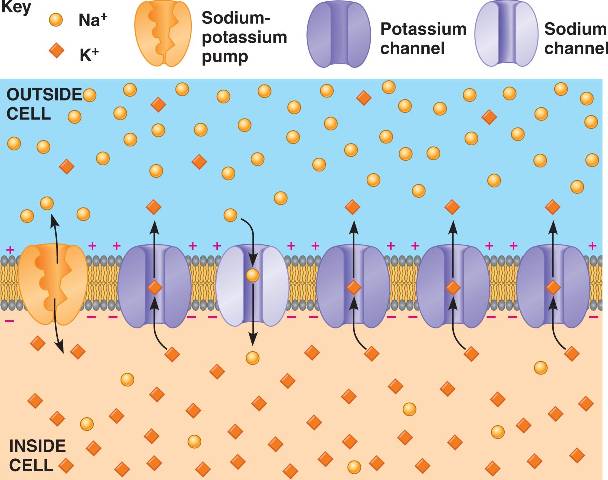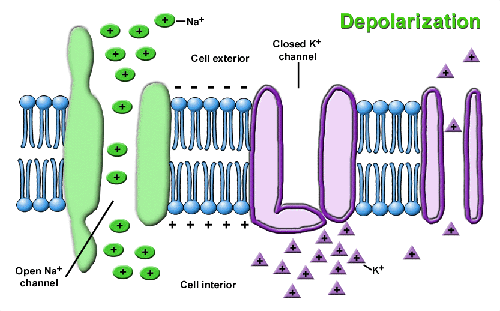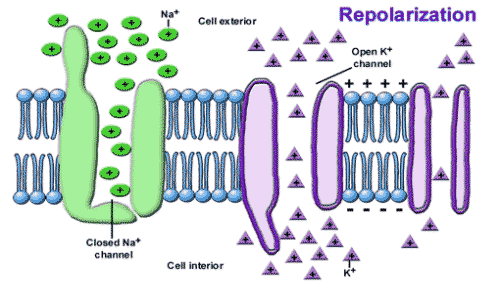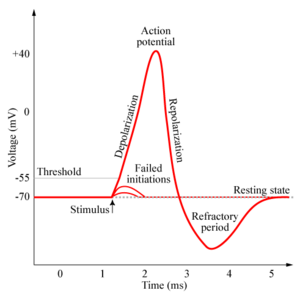Transmission of nerve impulse (Transmission of nerve impulse.com)
- When at rest the inside of the membrane has a –ve electrical potential compared to the outside.
- The difference in potential is called the resting potential and is typically about between -70 mv to -80 mv (-90mv)
- In this resting state the axon is said to be polarized.
- This is maintained because the neuron has an internal composition which is different to the outside.
- Na+ and k+ are transported across the membrane against their concentration gradients by active transport.
- Carrier proteins pick up Na+ ions and transport then to outside.
- At the same time k+ ions are transported into the axon.
- This is known as Na-k pump and relies on ATP from respiration.
- Inside the axon there are large numbers of –ve charged organic ions which cannot move out of axon.
- The Na+ ions are passed out faster than the k+ ions are brought in.
- Approx. 3 Na+ ions leave for every two K+ ions that enter.
- K+ ions can also diffuse back out quicker than Na+ ions can diffuse back in.
- Net result is that the outside of membrane is +ve compared to the inside.
The action potential (depolarization)
- A nerve impulse can be initiated by mechanical, chemical, thermal or electrical stimulation.
- When axon is stimulated the resting potential charges.
- It chare from -70mv inside the membrane to +40mv.
- For a very brief period the inside of the axon becomes +ve and the outside negative.
- The change in potential is called action potential and about 3 millisecond.
- When an action potential occurs the axon is said to be depolarized.
- When the resting potential is re-established the axon membrane is said to be repolarised.
- When the membrane depolarizes charges occur in the membrane to the permeability of both Na+ and K+ ions.
- When the axon is stimulated channels opens on its cell surface which allows Na+ ions to pass through.
- Na+ ions flood in by diffusion.
- The Na +ions create a +ve charge of +40mv inside the membrane reversing the resting potential and casting the action potential.
Repolarization
- K-channels open in the membrane and K+ ions diffuse out along their concentration gradient.This start of repolarization.
- At the same time sodium channels in the membrane close preventing any further influx of Na + ions.The resting potential is re-established as the outside of the membrane becomes positive again compared to the inside
- .So many k+ ions leave that the charge becomes more negative that it was originally.
- The potassium channels close and the Na-K pump start again.
- Normal concentrations of Na and K ions are re-established.
- The membrane is once again at its resting potential.
Direction of impulse
- In the resting axon, there is a high conc. Of Na+ ions outside and a high conc. Of K+ ions inside. But the net effect is that the outside is positive compared to the inside give the resting potential.
- The axon is stimulated producing an action potential setting up local circuits on the axon membrane.
- Na+ ions rush into the axon a diffusion gradient depolarising the membrane causing an action potential.
- As the action potential passes along the axon K+ ions diffuse along a concentration gradient starting off the process of repolarization.
- Na-K pump is re-established fully repolarization the membrane.






No comments:
Post a Comment